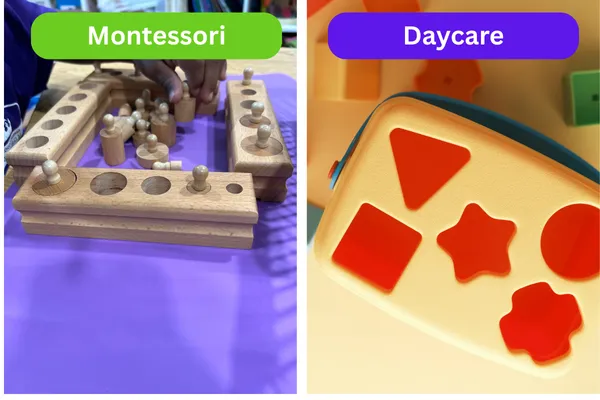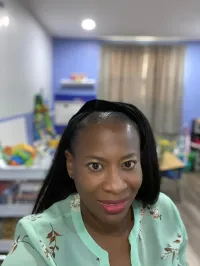
Montessori vs Daycare
Montessori vs Daycare: Which Early Childhood Program is Best for Your Child?
When it comes to choosing care for your little one, many parents are faced with two very different paths: traditional daycare or a Montessori preschool. While both environments provide supervision and early childhood education, their core philosophies and classroom materials could not be more different. One approach leans on convenience and mass appeal, while the other centers on intentional design, child development, and purpose-driven learning.
Let’s explore the differences through one of the most powerful lenses: the materials children use every day.
Montessori Materials: Real, Purposeful, and Designed for Growth
Walk into a Montessori classroom and you’ll notice something immediately: the materials are real. Children work with wooden trays, glass pitchers, wicker baskets, metal bowls, and ceramic dishes. These are not toys, but tools designed to teach specific concepts and encourage responsibility.
Dr. Maria Montessori believed that children absorb their environment through all their senses. She knew the weight, texture, and fragility of real materials contributed to a child’s growth. Wooden and glass items are heavier and require care when handled. If dropped, they might break. And that’s the point.
In Montessori, a child learns to treat objects with respect. A glass pitcher that breaks after careless handling teaches natural consequences far better than a teacher’s repeated warnings ever could. Over time, children learn that being gentle is not about fear, it’s about mastery and mindfulness.
Now contrast this with a typical daycare setting, where many materials are plastic, colorful, and virtually indestructible. On the surface, this seems ideal: fewer messes, fewer injuries, less cost. But what has the child learned when they knock a plastic bowl across the room, and it lands without a scratch? That it’s okay to throw things at home too? That materials are disposable and meaningless?
Montessori Work Materials Are Cross-Curricular
Another powerful feature of Montessori materials is their ability to teach multiple concepts at once, something daycare toys rarely do.
Let’s look at a few classic Montessori items:
Pink Tower: This set of ten wooden cubes teaches size discrimination, visual-spatial reasoning, and introduces mathematical sequencing (largest to smallest). Children build concentration and motor control while exploring volume and dimension.
Brown Stair: These rectangular prisms differ only in width, helping children isolate one quality (breadth) while refining muscular coordination and early geometry concepts.
Knobbed Cylinders: These wooden cylinders vary in height and diameter, helping children refine their pincer grip (a pre-writing skill) and introducing the mathematical concept of gradation.
While a daycare center may offer stacking toys or colorful blocks, these tend to be random in size, shape, and concept. They’re often used simply to entertain or pass time, not to build progressive understanding.
In Montessori, there’s always an underlying academic foundation. For example, a Practical Life activity like pouring water from a small glass pitcher is preparing the child’s hand and eyes for writing. Using tongs to transfer small objects develops fine motor strength necessary for holding a pencil. Matching fabrics or textures sharpens sensory perception, which lays the foundation for reading and categorizing information later on.
Daycare Toys vs Montessori Materials: What's the Message?
Daycare environments often emphasize fun, color, and quantity. The focus is usually on keeping children entertained and safe until pickup time. There might be singing, dancing, plastic toy stations, and themed crafts, all good things in moderation, but not necessarily tied to a developmental plan.
Montessori classrooms, by contrast, are calm, orderly, and intentional. The shelves aren’t crammed with every toy under the sun. Each item is carefully chosen for its developmental purpose. And rather than rotating through chaotic free play, children in Montessori environments choose their work, complete it, and return it to its place, building independence and responsibility.
Let’s put it this way: plastic toys are designed for durability. Montessori materials are designed for growth.
What Happens at Home?
It’s worth considering how early childhood environments shape home behavior. If your child spends hours in a space where objects can be thrown, dropped, and mishandled without consequence, don’t be surprised when they come home and treat your furniture or dishes the same way.
But when a child is used to working with glass and ceramic, you may notice they carry their juice with two hands. They place things down carefully. They use both focus and intention because that’s what their environment has taught them.
Montessori doesn’t just change how children learn, it changes who they become.
The Takeaway
Daycare and Montessori may both fall under the banner of "childcare," but the similarities often stop there. If you want a place where your child is safe and entertained, daycare might suffice. But if you’re looking for an environment that nurtures independence, concentration, academic readiness, and emotional intelligence, Montessori is the gold standard.
The difference is in the materials.
Real, beautiful, and intentional tools don’t just occupy your child’s time. They elevate your child’s mind.
And that makes all the difference. To learn more about our Montessori program, click here:

